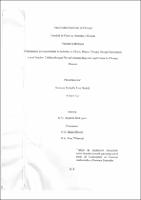| dc.contributor.advisor | Rincón, Rafael | |
| dc.contributor.advisor | Villarreal, Rosa | |
| dc.contributor.author | Ríos Madrid, Katiusca Michelle | |
| dc.date.accessioned | 2023-10-03T15:38:39Z | |
| dc.date.available | 2023-10-03T15:38:39Z | |
| dc.date.issued | 2018 | |
| dc.identifier.uri | http://jadimike.unachi.ac.pa/handle/123456789/952 | |
| dc.description.abstract | Los helechos son plantas vasculares que carecen de flores y semillas y están dentro
de las plantas más antiguas. Taxonómicamente, los helechos son uno de los grupos más
diversos y abundantes en los bosques tropicales húmedos. En Panamá existen algunos
estudios taxonómicos de helechos; sin embargo, existen pocos estudios sobre la ecología de
este grupo. Por esta razón, e] objetivo de este trabajo fue comparar ]as comunidades de
helechos en el Sendero Culebra (Bosque Pluvial Montano Bajo) y en Chorro Blanco (Bosque
Pluvial Premontano). La investigación fue realizada en los distritos de Boquete (Sendero
Culebra) y Boquerón (Chorro Blanco). En cada sitio se establecieron cinco parcelas de 10 x
10 m, cada una se subdividió en 25 subparcelas de 2 x 2 m, siendo muestreadas 15
subparcelas a] azar. Se recolectaron todos ]os helechos presentes y se registró e] número de
individuos y la cantidad de especies por parcela. En ambos sitios se determinó la riqueza,
diversidad, equitativídad y abundancia de ]as especies. Se obtuvo un total de 82 especies
distribuidas en 29 géneros y 13 familias. Al comparar la riqueza de especies, Sendero Culebra
registró un total de 61 especies; mientras que en Chorro Blanco se logró identificar 34
especies. El índice de Shannon-Weaver determinó que la diversidad es alta en ambos sitios
(Sendero Culebra H'= 3.51 y Chorro Blanco H'= 3.07). De las 82 especies identificadas; 69
(84.15 %) estuvieron presentes en un sólo sítio (Sendero Culebra o Chorro Blanco) y 13
(15.85 %) estuvieron presentes en ambos sitios. En Sendero Culebra (J= 0.85) y en Chorro
Blanco (J- 0.87) existe un buen nivel de equidad en la abundancia entre las especies de ambos
sitios. La abundancia de especies fije mayor en Sendero Culebra con un total de 274
individuos, mientras que, Chorro Blanco presentó una menor abundancia con 148 individuos.
Los resultados obtenidos demuestran que en el Sendero Culebra los helechos presentan una
mayor riqueza, abundancia y diversidad; sin embargo, ambos sitios comparten 13 especies.
Posiblemente, esto se debe a que en Chorro Blanco las condiciones ambientales, edificas,
topográficas son menores, mientas que, el nivel de intervención humana es mayor. Este
estudio es un aporte al conocimiento de la ecología y biodiversidad de los helechos en nuestro
país, de igual forma, contribuye para la creación de planes de mando y conservación de los
sitios estudiados. | es_ES |
| dc.description.abstract | Fem's are vascular plants that do not produce flowers and deeds and they are among
the oldest planté. Taxonomically, ferns are one of the mast diverge and abundant groups in
tropicalrainforests. In Panama there are some taxonomic studios off ferns; however, there are
few studies on the ecology of this group. The main reason of this work was to compare the
communities of ferns in the Sendero Culebra (Low Montane Rain Forest) and in Chorro
Blanco (Premontane Rain Forest). The research was ín the districts of Boquete (Sendero
Culebra) and Boqueron (Chorro Blanco). In each site five plots of 10 x 10 m were established,
each one was subdivided into 25 subplots of 2 x 2 m, with 15 subplots randomly sampled
All the berns present there were collected and tale number of individuals and the number of
species per poot were recordad. In both giles üie richness, diversity, faimess and abundante
ofthe species were determined. A total of 82 species distributed in 29 genera and 13 fainilies
were obtained. When comparing species richness, Sendero Culebra registered a total of 61
species; while in Chorro Blanco 34 species were identified. The Shannon-Weaver index
Determined that diversity is high at both sítes (Sendero Culebra H'= 3.51 and Chorro Blanco
H'= 3.07). Of the 82 identified species; 69 (84.15%) were present in only one site (Sendero
Culebra or Chorro Bianco) and 13 (15.85%) were present in both sites. In Sendero Culebra
(J- 0.85) and in Chorro Blanco (J- 0.87) there is a good level of equity in abundance between
the species of both sites. The abundance of species was higher in Sendero Culebra with a
total of 274 individuals, while, Chorro Blanco had a lower abundance with 148 individuals.
The results obtained show that in the Sendero Culebra the ferns present a greaser richness,
Abundance and diversity; however, both sites stare 13 species. Possibly, this is due to the
fact that in Chorro Blanco the environmental, soil and topographic conditions are lower,
while the level of human íntervention is greate. This research is a contribution to the
knowledge of the ecology and biodiversity of ferns in our country, in the same way, it
Contributes to the creation of management plans and conservation of the studied sites. | |
| dc.language.iso | es | es_ES |
| dc.publisher | Universidad Autónoma de Chiriquí | es_ES |
| dc.subject | TESIS - CIENCIAS AMBIENTALES Y RECURSOS NATURALES | es_ES |
| dc.subject | FLORA - DIVERSIDAD | es_ES |
| dc.subject | RECURSOS NATURALES | es_ES |
| dc.subject | HELECHOS - DIVERSIDAD - DAVID, CHIRIQUÍ (PANAMÁ) | es_ES |
| dc.title | Comparación de comunidades de helechos en Chorro Blanco (bosque pluvial premontano) y en el Sendero Culebra (bosque pluvial bontano bajo) en la provincia de Chiriquí, Panamá. | es_ES |
| dc.type | Thesis | es_ES |

